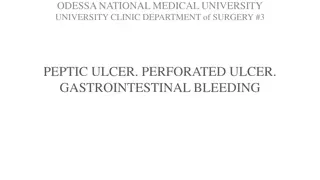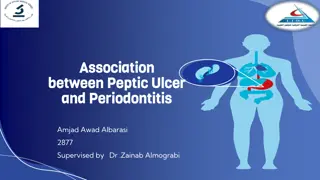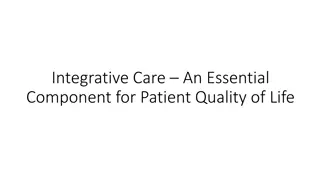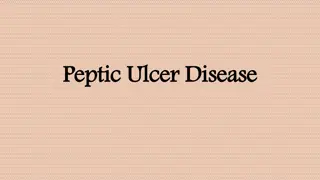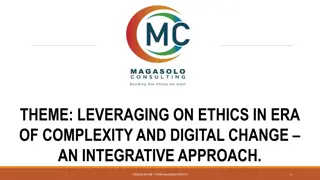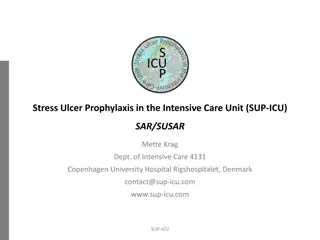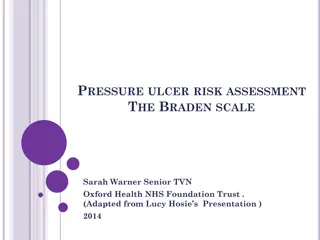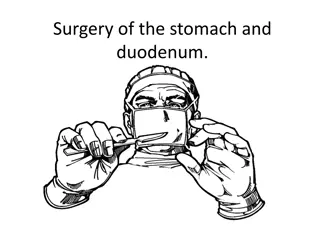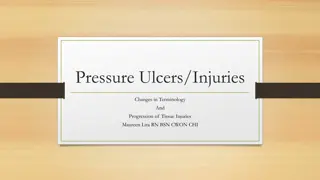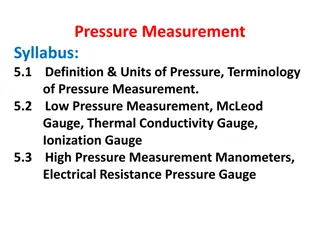Integrative Care for Stage III Pressure Ulcer Patient
This case presentation focuses on the comprehensive care of a 75-year-old Hispanic male with a stage III pressure ulcer on the sacrum. It includes information on demographics, medical history, medications, subjective and objective assessments, as well as the integration of evidence-based complementary and alternative medicine (CAM) treatments. By incorporating lifestyle modifications, honey dressings, and Iyengar Yoga therapy, the aim is to provide a holistic approach to healing and managing the patient's condition.
Download Presentation

Please find below an Image/Link to download the presentation.
The content on the website is provided AS IS for your information and personal use only. It may not be sold, licensed, or shared on other websites without obtaining consent from the author. Download presentation by click this link. If you encounter any issues during the download, it is possible that the publisher has removed the file from their server.
E N D
Presentation Transcript
Case Presentation: The Integrative Care of a Patient Diagnosed with Stage III Pressure Ulcer By: Rakhi Sharma CSUSM MSN Cohort -9
OBJECTIVES After attending this case presentation, participants will be able to: Describe the Epidemiology of Pressure Ulcers. Identify risk factors for developing Pressure Ulcers Incorporate evidence-based CAM into the plan of care for a patient diagnosed with Pressure Ulcers. Analyze a case presentation of a 75 years old patient diagnosed with Stage III Pressure Ulcer.
Demographics 75 years old Hispanic male, with 6 months history of stage III pressure ulcer on the sacrum , secondary to immobility and incontinence. Medical History Type 2 Diabetes- diagnosed at age at age 35, Hyperlipidemia , Diabetic foot ulcers, Diabetic neuropathy. Surgical History Right leg below knee amputation, 5 years ago- at age 70. Family History Mother - Type two Diabetes, Hypertension and ESRD-passed away ay age 56. Sisters - age 50 and 58 with Type 2 Diabetes.
PRESENT THE PATIENT List of medications: Metformin 500 mg P.O. BID. Atorvastatin 40 mg P.O. daily. Gabapentin 300 mg P.O BID Norco 5mg every 4 hours P.O PRN for pain Use of CAM including lifestyle modifications. Daily wound care with Honey dressings. Iyengar Yoga Therapy Intervention Recommended change in diet, exercise or yoga daily.
PRESENT THE PATIENT REVIEW OF SYSTEM ( SUBJECTIVE) 75,year old male with complaints of pain due to Stage III pressure ulcer. Denies shortness of breath, chest pain. Reports tenderness on bilateral greater trochanteric areas. Reports unable to ambulate w/o assistance, mostly wheelchair bound Nutrition poor Reports that he is able to move himself slightly in bed but needs complete assistance to get out of bed. Reports episodes of incontinence both bowl and bladder. Feels depressed due to disease process ( immobility , poor healing pressure ulcer).
PRESENT THE PATIENT Physical Examination (Objective) Vitals: T98.0, R 20, BP 120/70, P 80 and regular, Wt 60 kg, Ht 180 cm, Labs: HgbA1C- 6.8% General: Well groomed. Sitting in a wheel chair. HEENT - unremarkable Neck - supple, No JVD, no bruit, no lymphadenopathy Heart - RRR w/o murmur , no S3 nor S4 Lungs - Bilateral lower lobe end inspiratory crackles, no rhonci Abdomen - BS+ x 4 Q, no mass or organomegaly Extremities - slight tenderness to palpation over bilateral greater trochanters R>L. Left leg pulses intact in posterior tibial and dorsalis pedis. Right leg with BKA , stump without any skin breakdown. Skin - Stage III diabetic ulcer noticed on the sacrum measuring 3inch x 3inch x 3 cm deep, No tunneling . Scant purulent drainage was observed , wound bed covered with white slough.
Sensory = 2; Moisture = 3; Activity = 2; Mobility =2; Nutrition = 3; Friction = 1; Total Score = 13 (<18 high risk)
PRESENT THE PATIENT: Assessment Diagnosis: - Stage III Pressure Ulcer Differential Diagnosis: - Compromisedskin integrity Secondary to age, immobility, incontinence and poor nutrition. Plan: - Daily wound care with Honey dressings. - Iyengar Yoga Therapy Intervention -Nutritional consultation and/or institute dietary supplements.
PRESENTATION OF THE CLINICAL PROBLEM Skin injuries like pressure ulcers, diabetic, venous and arterial ulcers are becoming a significant problem in all healthcare settings specially effecting geriatric population. Epidemiology : According to Agency for Healthcare Research and Quality ( AHRQ) Each year, more than 2.5 million people in the United States develop pressure ulcers. These skin lesions bring pain, associated risk for serious infection, and increased health care utilization.
PRESENTATION OF THE CLINICAL PROBLEM Pressure ulcers remain a serious problem among geriatric population ,despite regulatory and market approaches to encourage prevention and treatment. Pressure ulcers cause pain, disfigurement, and increased infection risk. They are associated with longer hospital stays and increased morbidity and mortality.
PRESENTATION OF THE CLINICAL PROBLEM Etiology/Pathophysiology Different Stages Of Tissue Injury
PRESENTATION OF THE CLINICAL PROBLEM Risk factors include: Immobility. Lack of sensory perception. Poor nutrition and hydration. Medical conditions affecting blood flow such as Diabetes and vascular disease.
PRESENTATION OF THE CLINICAL PROBLEM Therapeutic interventions Daily wound care with honey dressing. Patient repositioned every 2 hours. Implement an incontinence management plan to prevent exposure to chemicals in urine and stool that can strip or erode the skin. Assess Patients nutritional status; refer for a nutritional consultation and/or institute dietary supplements. Pressure redistribution surface for the bed and wheelchair.
RETURN TO THE PATIENT: THE PLAN What did you try, What didn t work: -Implement an incontinence management plan to prevent exposure to chemicals in urine and stool that can strip or erode the skin. Patient refused bowel and bladder training or willingness to reposition himself every 2 hours. What worked: Daily wound care with honey dressing. The natural antiseptic properties of honey soothe the mild bed sores in the skin. It can provide relief from pain, reduce itching and promote healing . Honey can also reduce the risk of infection. Family and caregivers help and encourage patient to be repositioned every 2 hours. Pressure redistribution surface for the bed and wheelchair.
RETURN TO THE PATIENT: THE PLAN Current Plan : Continue daily wound care with honey dressing. Continue to reposition patient every 2 hours. Continue to implement an incontinence management plan to prevent exposure to chemicals in urine and stool that can strip or erode the skin. Nutritional consultation and/or institute dietary supplements. Continue use of Pressure redistribution surface for the bed and wheelchair. Continue oral anti-hypoglycemic medication and pain management medications. Future Plan : Iyengar Yoga Therapy for upper body strength, so that the patient can reposition or transfer in and out of chair and bed. Routine follow up to prevent complications.
SUMMARY 75 years old Hispanic male, with 6 months history of stage III pressure ulcer on the sacrum , secondary to immobility and incontinence. Medical history of Type 2 Diabetes- diagnosed at age at age 35, Hyperlipidemia , Diabetic foot ulcers, Diabetic neuropathy. Surgical history of right leg below knee amputation, 5 years ago- at age 70. Feels depressed due to disease process ( poor healing pressure ulcer). Plan is for daily wound care with honey dressing, continue to reposition patient every 2 hours, continue to implement an incontinence management plan to prevent exposure to chemicals in urine and stool that can strip or erode the skin, Nutritional consultation and/or institute dietary supplements, continue use of Pressure redistribution surface for the bed and wheelchair, continue oral anti-hypoglycemic medication and pain management medications.
Conclusion Pressure ulcers, diabetic ulcers and chronic wounds can have a significant impact on a patient s quality of life. Wound healing is a complex biological process in human body, involving four major steps like homeostasis, inflammation, proliferation, and remodeling (Mosby, 2009, P. 1510). Honey has had a valued place in traditional medicine for centuries. Honey has been employed in wound care since ancient times. Many cultures and ethnic groups has incorporated and used honey as antibacterial to treat different illness and wound healing. China and India and many other nations have used honey as remedy for nearly every illness (Al-Waili et al, 2011). The natural antiseptic properties of honey soothe the mild bed sores in the skin. It can provide relief from pain, reduce itching and promote healing . Honey can also reduce the risk of infection.
References: AHRQ. (2016, April). AHRQ s Safety Program for Nursing Homes: On-Time Pressure Ulcer Prevention | Agency for Healthcare Research & Quality. Retrieved May 3, 2017, from https://www.ahrq.gov/professionals/systems/long-term- care/resources/ontime/pruprev/index.html Al-Waili, N. S., Salom, K., Butler, G., & Ghamdi, A. A. (2011). Honey and Microbial Infections: A Review Supporting the Use of Honey for Microbial Control. Journal of Medicinal Food,14(10), 1079-1096. doi:10.1089/jmf.2010.0161 Al-Waili, N. S., Al-Waili, F. S., Akmal, M., Ali, A., Salom, K. Y., & Ghamdi, A. A. (2014).Effects of natural honey on polymicrobial culture of various human pathogens. Archives of Medical Science,2, 246-250. doi:10.5114/aoms.2012.28603
Reference Reference Al-Waili, N., Salom, K., Al-Ghamdi, A., Ansari, M. J., Al-Waili, A., & Al-Waili, T. (2013). Honey and Cardiovascular Risk Factors, in Normal Individuals and in Patients with Diabetes Mellitus or Dyslipidemia. Journal of Medicinal Food,16(12), 1063-1078. doi:10.1089/jmf.2012.0285 American Diabetes Association. (2016). Classification and diagnosis of diabetes. Diabetes care 2016, 39(1). doi: 10.2337/dc16-S005
Reference Bergstrom, N., & Braden, B. (1992). A prospective study of pressure sore risk among institutionalized elderly. Journal of the American Geriatrics Society, 40(8), 747-758. Ribeiro, S. (2015). Iyengar Yoga Therapy Intervention for Ischial Pressure Ulcers in a Patient with Amyotrophic Lateral Sclerosis: A Case Study. The Journal of Alternative and Complementary Medicine, 21(9), 578-582. doi:10.1089/acm.2014.0163 Mosby's dictionary of medicine, nursing & health professions (8th ed.). (2009). St. Louis, MO: Mosby. Page- 1510



